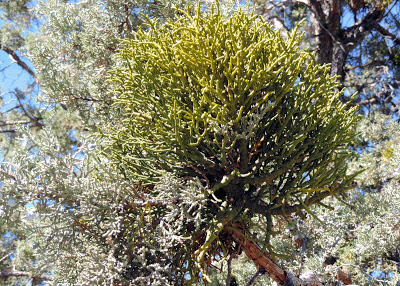Mistletoe is a plant parasite of trees – both deciduous and
conifer. Mistletoe on deciduous trees typically attach to stems, are
capable of photosynthesis, and are parasites of the xylem. Mistletoe on
conifers produce scales instead of leaves; the seedlings are capable of
photosynthesis, but the adult plants are dependent on their host, parasitizing
both xylem and phloem. The mistletoe causes distortions in the conifers, called
witches’ brooms. Mistletoes are dioecious, meaning they produce male (pollen)
and female (berries) reproductive structures on separate host trees.
 |
| Mistletoe in a sycamore |
The mistletoe is easiest to see in deciduous trees, when
they have lost their leaves in the fall. The mistletoe is evergreen and appears
as a leafy mass hanging off a branch. Here in the Bay Area, we frequently see
mistletoe in landscape trees. Broadleaf mistletoe (Phoradendron macrophyllum) infests alder, Aristocrat flowering pear, ash, birch, box elder, cottonwood, locust, silver maple, and walnut. P. villosum infests oaks. Arceuthobium spp. infests firs and pines.
 |
| Detail of mistletoe in a sycamore tree |
Birds feed on the berries and excrete the partially digested
seeds, which fall on branches. When a seed germinates, it sends haustoria into
the bark. The haustoria “takes root”, tapping into the xylem and/or phloem
transport systems and consuming nutrients and water. The mistletoe grows slowly
at first, but becomes embedded deep in the branch. The host tree may not look
as healthy as uninfected trees, since it is sharing its nutrition with its
parasite. A tree can support a mild infestation, but individual branches may
weaken; a heavily infested tree may eventually die, especially when the tree is
stressed by environmental conditions such as drought.
For management tips, see the Integrated Pest Management
(IPM) site. To manage the problem you must contain its spread as quickly as
possible. Prune infested branches at least one foot below the point of
attachment. For infestations on a branch or trunk, this may be a problem. The
IPM site recommends wrapping the area with wide, black plastic to cut off the light
source for the mistletoe, causing it to eventually die. Chemical treatment with
a plant growth regulator (ethephon, or Monterey Florel Brand) is possible. IPM recommends
planting resistant tree species, including Bradford flowering pear, Chinese
pistache, crape myrtle, eucalyptus, ginkgo, golden rain tree, liquidambar,
sycamore, and conifers such as redwood and cedar.

























